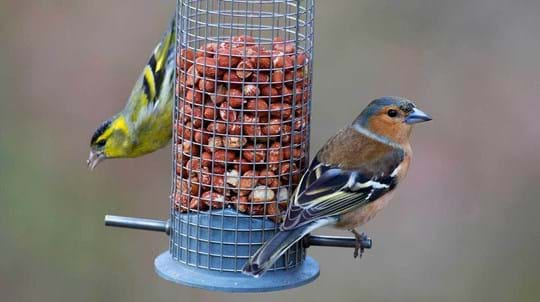
Trees woods and wildlife
Birds
Find out more about our declining woodland bird populations, and how protecting woodland habitats is more important than ever.

Digital content editor
Unassuming yet full of character, starlings are a garden staple. Their dark, iridescent plumage, pointed bill and lively walk make them stand-out visitors to the bird table, but their real wow-factor is in their get togethers.
Murmuration is the collective noun for a large group of starlings, but it’s also the name for the shapes they make while wheeling overhead – often in their thousands. But why are murmurations made up of so many birds?
Starlings are extremely social birds. UK residents live in flocks all year round, but every autumn their numbers are boosted by migrants flying in from Eastern Europe and Scandinavia, who come to escape the harsh weather and bitter cold. And it’s these visitors who help make each murmuration a breathtaking spectacle.
Thousands of starlings all swirling and swooping together means one thing: safety. The sheer volume of birds confuses predators like peregrine falcons and makes it much harder for them to pick off individual birds.
The characteristic shapes of a murmuration come from the rapid changes in direction. Starlings have extremely fast reactions, so when one bird changes speed or direction, the birds around it do too. It’s a bit like a birdy one-upmanship. It also allows the birds to move within the murmuration itself, meaning that no one bird spends too much time at the edge of the group, where they’re vulnerable to predation.
But safety isn’t the only reason they flock together. Lots of birds snuggled up together makes for a much warmer roost, increasing an individual’s chances of surviving the cold winter nights. And it’s the perfect place to communicate and socialise.
The largest murmurations happen during winter, though birds will start to gather in greater numbers from autumn.
Look to the skies from sunset and into the early evening from November to February and early March to catch the spectacular display. Murmurations will be at their biggest and best at this time, before migrant birds start returning to their summer homes and our resident birds start getting ready for the breeding season.
During the colder months, look out for murmurations twisting and turning over sheltered habitats such as reedbeds, cliffs and woodlands, as well as manmade structures like piers, which will be their roost for the night.
Once the birds are satisfied the coast is clear, individuals will peel off from the main group in coordinated descents, settling into the roost with a loud flurry of wings and chattering – a spectacle in itself!
Flocks of starlings can often be seen coming into roost over towns across the UK in autumn, as well as at nature reserves with good roosting cover.
The number of starlings roosting at well-known sites varies from year to year, so it can be useful to check online forums for up-to-date information. Always arrive well before dusk for your best chance of seeing the full spectacle.
Famous murmuration sites include:
So find a sheltered spot and settle in at dusk, just as daylight begins to fade, and get set for one of the UK's greatest avian extravaganzas.

Trees woods and wildlife
Find out more about our declining woodland bird populations, and how protecting woodland habitats is more important than ever.

Blog
Kayleigh Jacobs-Rutter • 13 Feb 2024

Blog
Amy Lewis • 22 Feb 2018

Blog
Charlotte Varela • 21 Jan 2025

Blog
Amy Lewis • 28 Feb 2019

Blog
Hannah Vickers • 21 Mar 2019
Blog
Charlotte Varela • 10 Apr 2019

Blog
Hannah Vickers • 17 Jan 2019

Blog
Charlotte Varela • 21 Dec 2023